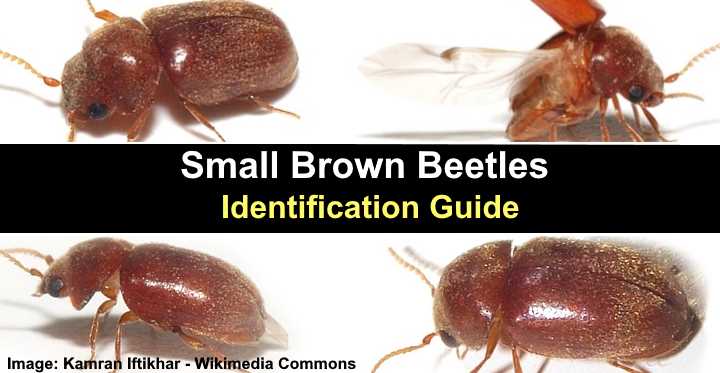Small brown beetles can be a nuisance both indoors and outdoors. These tiny insects are often found in pantries, where they crawl through dried grains, infest carpets, and bore into furniture. Two common types of small brown beetles found indoors are biscuit beetles and larder beetles.
In gardens, brown click beetles, European chafers, and June beetles can cause damage to plants and lawns. Identifying small brown beetles can be challenging due to their small size, which ranges from 0.082″ to 0.15″ (2 mm) for some indoor beetles to up to 0.78″ (20 mm) for outdoor beetles. This article provides descriptions and images to help identify these tiny brown insects in homes and yards.
Small Brown Beetle Facts
Brown beetles typically have an oval body with six legs and two antennae. There are thousands of beetle species within the insect order Coleoptera. Most adult beetles have two sets of wings, with the first pair serving as wing covers. While some small brown beetles can be pests indoors, not all brown beetles are considered pests.
Small Brown Beetle Identification
The body form, behavior, and habitat of tiny brown beetles can all be used to identify them. To help determine the species, look at whether the brown beetle has an oval or extended rounded body.
Moreover, some beetles have a huge, spherical head, but others have a tiny head and club-like antennae. The antennae can be used to identify the species of brown beetle. Several antenna designs, including serrated, segmented, and club-like antennas, are available.
Is there a long, unusual snout on the brown bug you saw in your house? The brown beetle is a kind of weevil in this instance. The elongated body and long projecting snout that Brown weevils employ to consume food differentiate them from other beetles.
Small Brown Beetles in the House
Discovering small brown bugs in a box of flour or cereal can be alarming, but these beetles can also be found throughout the home. They can infest various areas, such as bedrooms, bathrooms, and living rooms. Brown beetles may be present in carpets, soft upholstered furniture, medicine cabinets, and baking mixes. If you are wondering about the identity of the brown bug in your house, read on to learn more about different types of brown beetles.
Biscuit Beetle (Stegobium paniceum)
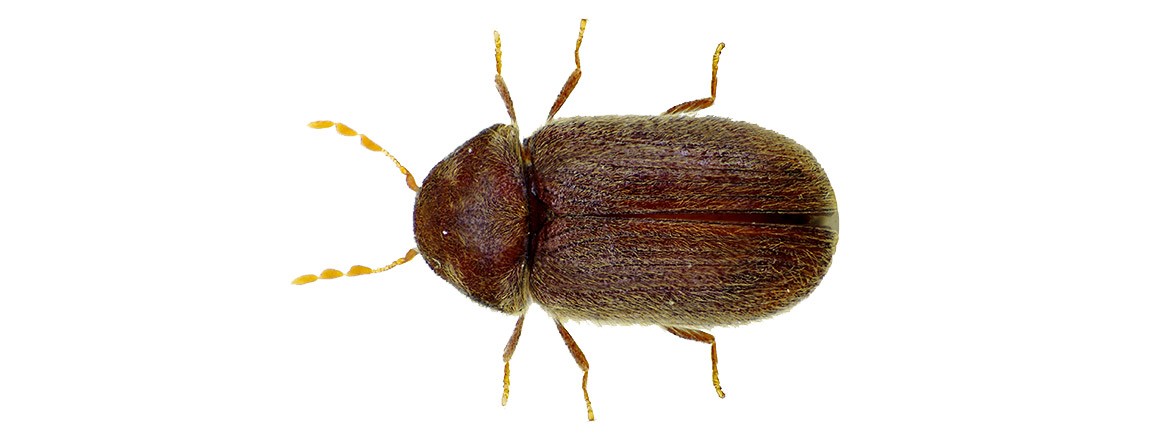
Tiny brown biscuit beetles are a common type of beetle found in dried food items such as flour and spices. They have a hard shell and a cylindrical body that is reddish-brown in color.
These tiny insects are usually 0.86 to 0.13 inches (2.5 to 3.5 mm) long and have club ends with three segments, making them easy to identify. Biscuit beetles are also known as drugstore beetles, biscuit weevils, and bread weevils.
They are known to feed on wool, leather, and hair as well. To keep them out of your food, make sure to check food packaging when bringing groceries home, store dry foods in airtight containers, and clean up any spills or crumbs in the pantry or under appliances.
Varied Carpet Beetle (Anthrenus verbasci)

The varied carpet beetle is a type of small brown beetle with a mottled body that is brown, white, and yellowish in color. Its body is shield-shaped and is smaller than its tiny head and black shabby antennae. These beetles range in size from 0.07 to 0.14 inches (1.7 to 3.5 mm).
Varied carpet beetles prefer to eat natural fibers and can cause damage to carpets, textiles, and furniture in your home, particularly the larvae. The larvae of the varied carpet beetle are tiny, furry, brown caterpillars that are about 0.2 inches (5 mm) long.
To identify a varied carpet beetle, look for its segmented antennae, six spindly legs, and mottled brown body that is almost round in shape.
Larder Beetle (Dermestes lardarius)
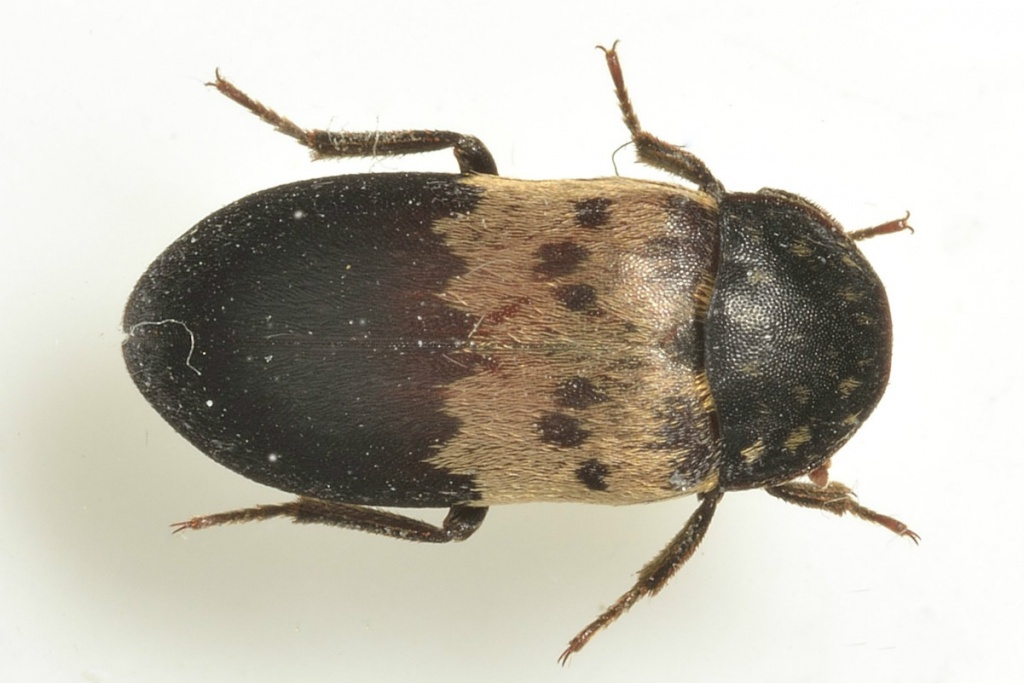
Larder beetles are small black and brown beetles with a six-legged body and club antennae with segmented ends. They feed on dried foods such as dry meats, cheeses, grains, and pet food. Adult larder beetles have a length of 0.33 to 0.38 inches (83 to 95 mm) and can be recognized by the brownish band with six black dots on their back.
Larder beetles got their name because of their frequent presence near food items. They can also create holes in wood and drywall as their larvae feed on these materials. To prevent larder beetles from infesting your home, store all dry food items in closed containers, securely seal trash cans, and don’t leave pet food out overnight.
Another name for larder beetles is moisture bugs, as they are often found near sources of moisture. To keep them out of your home, it is important to repair any leaking plumbing.
Small Brown Beetle Identification: Larder beetles are easily recognizable by the brown to tan band on their back with three black spots on either side. Their club antennae and black head also distinguish them from other small brown beetles.
Red Flour Beetle (Tribolium castaneum)

The red flour beetle is a small reddish-brown beetle commonly found in dried foods, and it can infest homes. These beetles have brown or rusty bodies and are approximately 0.13″ (3.1 mm) long with an oval-shaped abdomen that is easily noticeable. They can also use their wings to travel short distances. If you see these tiny red flour beetles flying or crawling around, it is a clear indication of their presence in your home.
Moreover, cereal boxes often have holes in them, and reddish-brown beetles can be found in flour and other cereals. To avoid attracting these beetles, it is advisable to store dry food items in airtight containers, as with other brown beetles in the home.
Small Brown Beetle Identification: The red flour beetle is identified by its reddish-brown oval body, which has three distinct antennae and a three-segmented club end.
Furniture Beetle (Anobium punctatum)
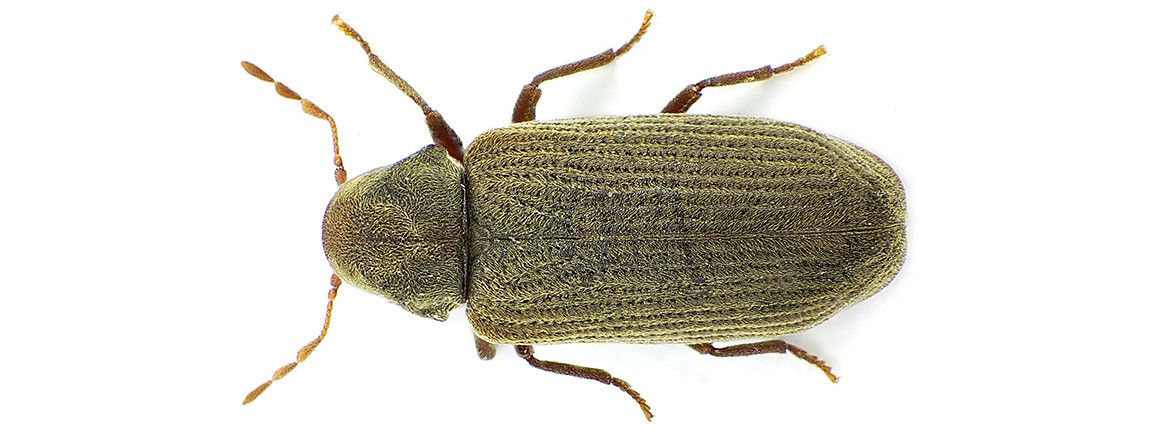
The furniture beetle is a small blackish-brown insect with six legs that can cause significant damage to wood and other household items. They can grow up to 2.7 to 4.5 mm in length, and they have a dark body with ridges and dimples as well as segmented antennae.
While adult furniture beetles are not harmful, it’s their larvae that cause damage to wood by boring holes into it. Furniture beetles and their larvae thrive in moist wood and high humidity environments, which are commonly found in homes.
Small Brown Beetle Identification: Furniture beetles have an elliptical body and a dark brown color, and their prothorax is noticeable as a monk’s cowl or hat.
Cigarette Beetle (Lasioderma serricorne)
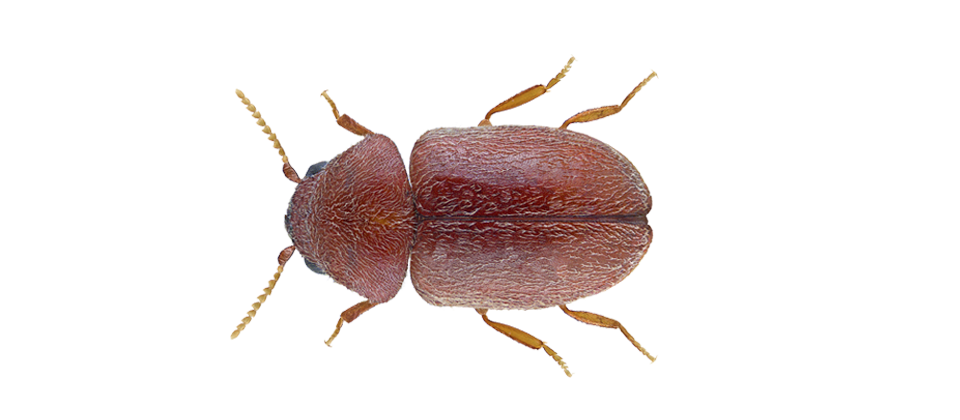
A cigarette beetle is a tiny, oval-shaped brown beetle with fine hair covering its body, and it is attracted to dried tobacco products and dry food items. These little brown beetles typically measure between 0.78 to 0.11 inches (2 to 3 mm) and may be found in dark corners or in stored dry food products.
The name “cigarette beetle” comes from their fondness for dry tobacco products. While similar to the oval brown drugstore beetle, cigarette beetles have serrated antennae instead of club-like antennae and a smooth body without ridges.
Small Brown Beetle Identification: Drugstore beetles can be identified by their brown, oval-shaped bodies, tendency to conceal their head and legs when startled, and ability to remain still.
American Spider Beetle (Mezium americanum)
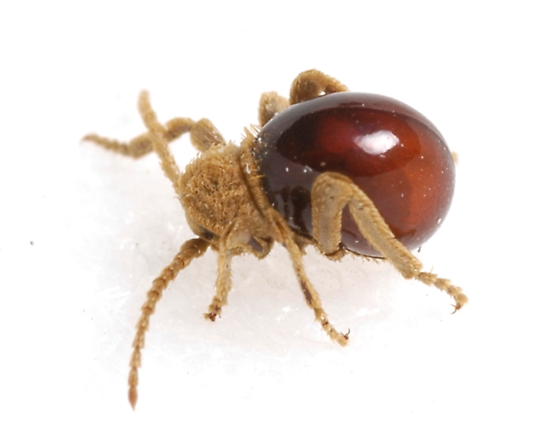
The American spider beetle is a small reddish-brown beetle that looks like a spider due to its rounded abdomen and thin wing coverings. It has tan-colored slender legs and segmented antennae, measuring only 1.5 to 3.3 mm (0.06 to 0.13 inches) in length.
When it comes to food, the brown American spider beetle can be a nuisance. They can infest stored foods such as cereals, dried fruits, seeds, beans, bread, and spices. Tobacco and cayenne pepper are also attractive to them. To prevent these pests from entering your pantry, it is essential to store food in airtight containers.
Small Brown Beetle Identification: The American spider beetle has a bulbous and glossy body with a tan-colored head and six long light-brown legs.
Types of Small Brown Beetles
Ornamental plants, as well as their larvae, may be attacked by tiny brown beetles that can be found in yards and gardens.
June Beetles
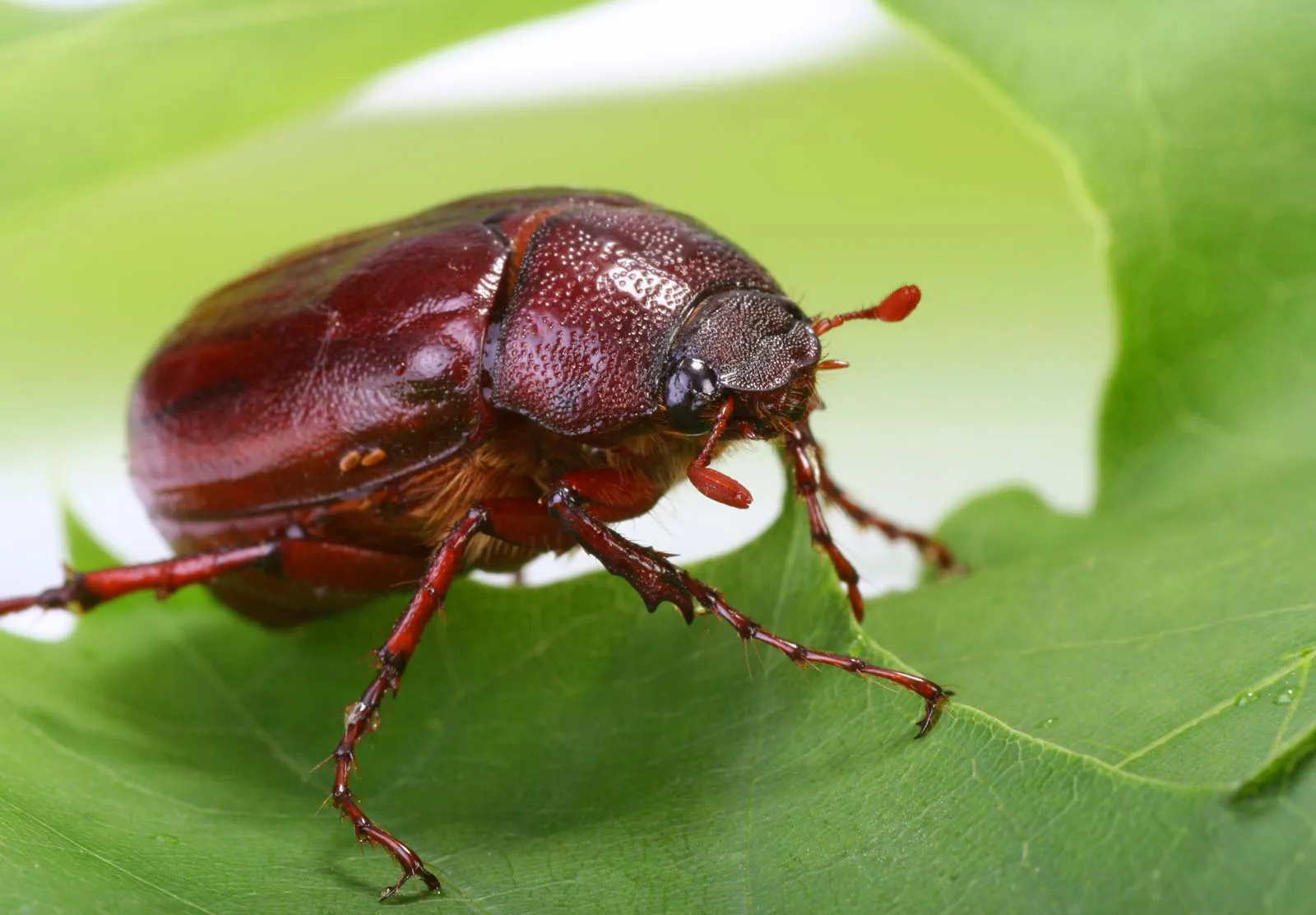
There are over 900 species of June beetles in the Phyllophaga genus, with some having a shiny dark brown or reddish-brown coloration. Commonly known as June bugs, these brown beetles range from 0.47 to 1.38 inches (12 to 35 mm) in length, and have short antennae and a glossy body with spiny legs.
Adult chafers are a type of June beetle that can be found feeding on deciduous leaves in the summer. They are commonly found on broadleaf trees, ornamental shrubs, and flowering plants. White grubs, which are beetle larvae, can also be found in the soil and can cause damage to plant roots and turfgrass.
Other species of June beetles in the Cotinis genus have dull brown bodies with green stripes, but there is a wide range of colors within the genus, with some beetles having bright green exoskeletons.
Small Brown Beetle Identification: The Brown June beetle has a metallic red body with spiny legs and short antennae.
Rice Weevil (Sitophilus oryzae)
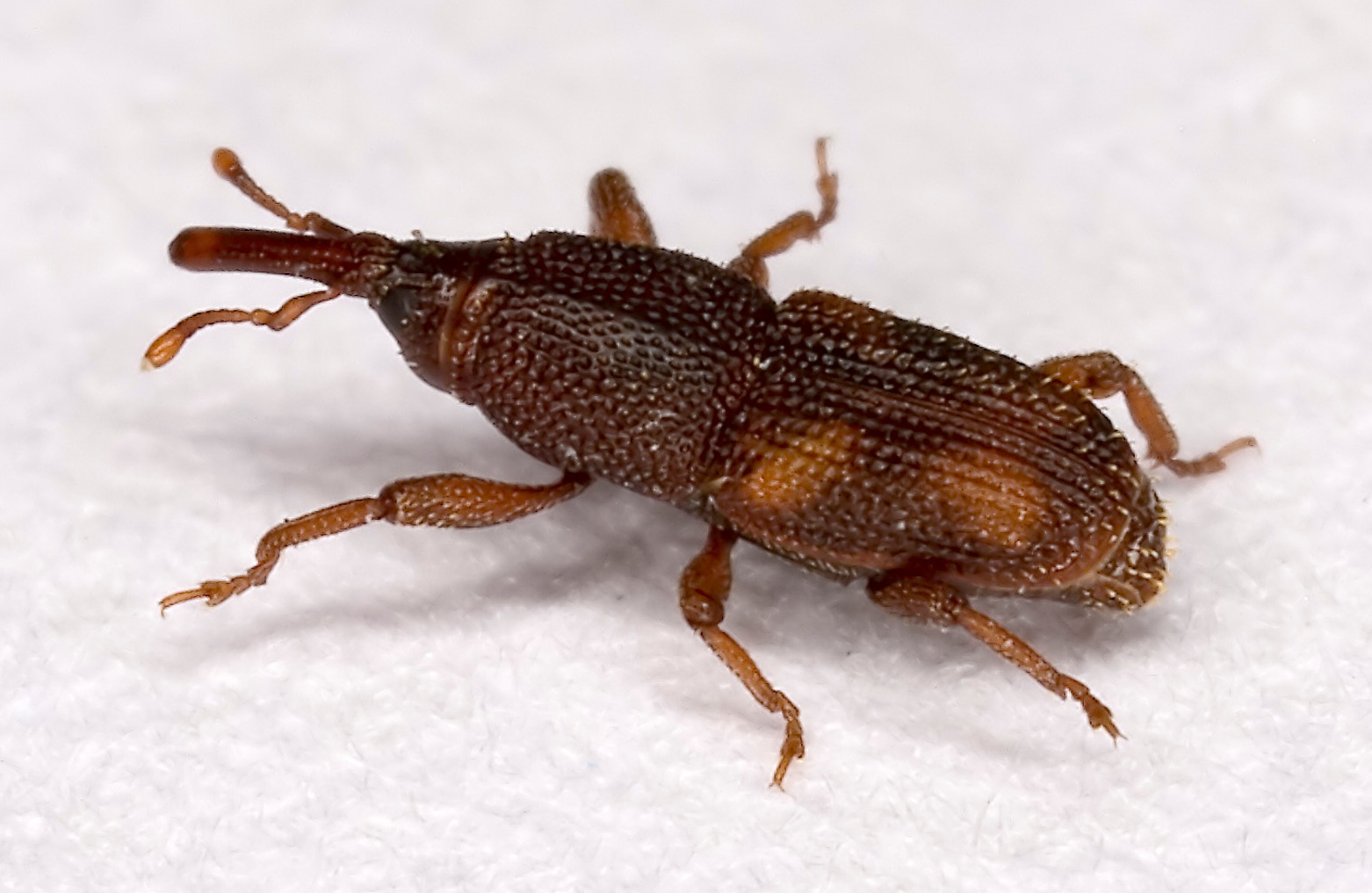
The rice weevil is a small brown beetle with an elongated oval body and a distinctive elongated snout. The body of this dark orange-brown insect has unique markings on its wing covers. Depending on the specimen, the unusual bug can range from 0.11 to 0.17 inches (3 to 4.5 mm) in length. Maize weevils closely resemble these destructive pests.
According to experts, rice weevils are one of the most serious grain pests globally. These brown bugs can fly and attack stored grains and cereals. After laying eggs in dry food items, the larvae develop into brown weevils.
Small Brown Beetle Identification: Rice weevils have distinct yellow or reddish markings on their hard wing coverings. They have a long snout on their head and a distinctive pitted appearance on their prothorax.
Click Beetles (Elateridae)
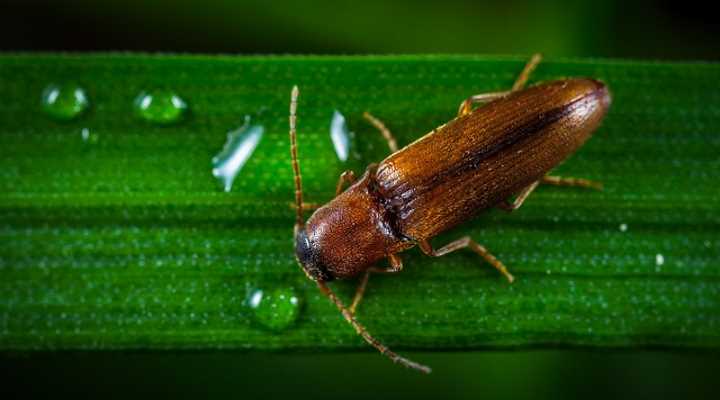
Denticollis linearis is a tiny brown beetle from the Elateridae family, also known as click beetles. These black or brown beetles are usually less than 0.78 inches (20 mm) long and have an elongated body with a fused head. A black band runs down the glossy brown body of the click beetle.
Click beetles are mostly nocturnal, so they are rarely seen during the day. Most Elateroidea species have serrated antennae and markings on their head and back, and they can “click” themselves into the air to escape danger, although there may be slight color variations between them.
Small Brown Beetle Identification: The slender and elongated brown body of click beetles, their black markings on wing covers, and their ability to make an audible clicking sound when they “jump” into the air.
Asiatic Garden Beetle (Maladera castanea)

The Asiatic garden beetle is a tiny flying brown beetle that can cause damage to garden plants. Its cinnamon-brown body has a resemblance to a coffee bean. These pesky flying beetles can grow up to 0.37 inches (9 mm) when attracted to lights during the night. They can enter homes through poorly-sealed doors and windows, becoming more of a household annoyance than a serious threat.
Although brown beetles are not a significant threat, they can cause damage to plants such as geranium, rose, chrysanthemum, and aster leaves and flowers in your yard. In addition, white grubs that live in the soil can cause brown patches on lawns.
Small Brown Beetle Identification: The Asiatic garden beetle has a cylindrical body with spiky antennae and six spiny legs.
European Chafer (Amphimallon majale)

The European chafer is a small reddish-brown beetle with spiny light brown legs and a prothorax that is active during late spring and summer. If you examine this brown beetle up close, you may notice light-yellow tufts of hair on its body. The beetle is typically 0.5 to 0.55 inches (13 to 14 mm) in length.
During summer, swarms of flying brown beetles, known as European chafers, can be observed. These beetles are usually found in shrubs and low trees. Dead European chafers’ corpses can also be found beneath the trees.
The larvae of European chafers are responsible for the damage to your garden, not the adults. When they hatch in the soil, the big white C-shaped grubs feed on the roots of trees, shrubs, and lawn grass. White grubs can cause brown patches in the grass. Wildlife digging up the larvae for food can cause even more harm.
Small Brown Beetle Identification: European chafers are distinguished by their oval brown bodies and grooves on their wing covers. They have two antennae with lamellae and legs with jagged spines.
Synchroa Bark Beetle (Synchroa punctata)
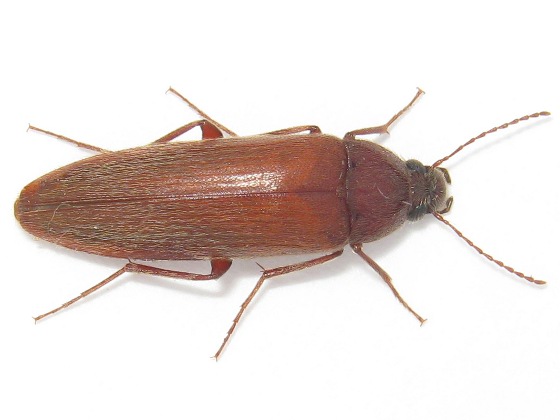
The synchroa bark beetle is a species of beetle that can cause harm to trees by feeding on their bark, which is typically dark brown or black in color. These beetles have elongated, bullet-shaped bodies that are flattened and feature thin lines on their wing covers. They also have long antennae and can range from 0.27 to 0.51 inches (7 to 13 mm) in length.
Bark beetles can be a serious threat to weakened trees as they feed and reproduce beneath the bark, removing nutrients and water from twigs and branches. Signs of their presence may include small holes and tube lines on the trunk or limbs.
